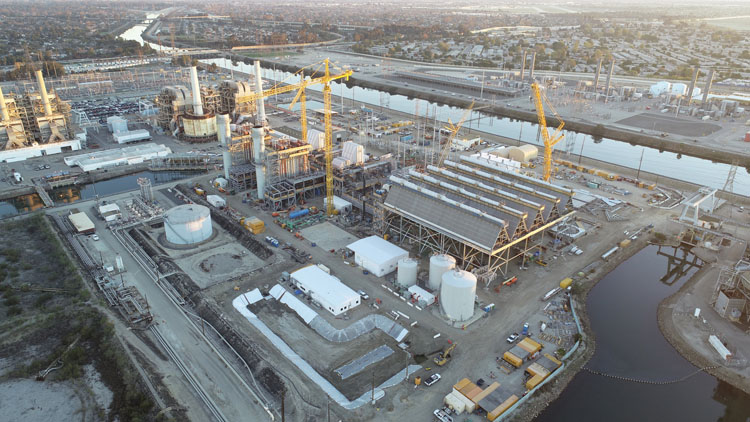
Construction of the new AES power plant at 690 Studebaker Rd. is continuing on schedule, with major construction operations set to be completed later this year. Stephen O’Kane, director of sustainability and compliance at AES Southland, told the Business Journal that the first crane tower at the site should come down at the end of this month, with the second being removed near the end of this year. Construction staffing, currently at peak levels, is scheduled to draw down in the spring. Commissioning and testing of the plant’s first gas turbine power block should commence at the end of 2019.
The Alamitos Energy Center began construction in 2017 to replace the existing steam generating station that was built in the 1950s. Compared to the old plant, the center’s two gas turbine power blocks will utilize 50% less fuel and 70% less fresh water to generate the same electrical service. Additionally, instead of using once-through ocean water cooling, a process being phased out across the state by 2020, the new plant uses an air condenser to cool its steam.
O’Kane emphasized that the phase-out of once-through cooling (OTC) was only one factor in the decision to modernize its plant. “There’s always been a desire for the company to invest in California,” he said. “What OTC did was put a hard schedule on [construction]. The markets were already going in those directions.”
The new energy center is being built to serve a grid that incorporates renewable energy sources like solar and wind. Last year’s Senate Bill 350 mandated that California must generate half its electricity from renewables by 2025, but these clean energies are being incorporated into a system built for fossil fuel plants.
The Alamitos Energy Center, powered by a combination of natural gas and steam, is designed to “smooth out” fluctuations in the renewable energy supply and even store excess energy. “The more intermittent solar and wind you put on, the harder it is,” O’Kane explained. “Even if it works perfectly, solar very predictably drops off like a stone about five o’clock at night. And then you have a massive ramp [up] when we need a whole bunch of power within half an hour to an hour.” O’Kane said peak energy consumption in California occurs around 7 p.m.
The intermittency of renewable generation requires modern plants to be able to switch on or off in minutes. By comparison, it takes the old steam plant between 10 and 36 hours to go from an active to inactive state.
The Alamitos Energy Center was designed with a total generating capacity of 1,040 megawatts (MW). As a rule of thumb, one megawatt can power roughly 1,000 homes, according to the California Independent System Operator, a nonprofit overseeing the state’s bulk electric power system. The plant is able to contain an additional 300 MW of power in battery storage units. AES has a building permit to construct two housing units for its battery units, though at this time it is only contracted for 100 MW of storage. The remaining 200 MW of battery capacity will be constructed if Southern California Edison determines more power is required on the grid. “It’s still an option,” O’Kane explained. “We’re here to respond to what’s needed.”
AES has already contracted a power purchase agreement with Edison for providing electricity from the center’s Power Block 1, which consists of two natural gas fired combustion turbine generators capable of providing 640 MW of power. AES has not yet secured a purchase agreement for Power Block 2, four simple-cycle combustion turbines able to generate 400 MW. Construction on that block would begin in the fourth quarter of 2020 if Edison chooses to contract for more power.
Demolition for the steam plant is scheduled to begin in 2021, but O’Kane said the work may begin earlier, in 2020. As a resident of the community, he emphasized that no detonations will be taking place in the area. “No one’s blowing up anything next door to my brand-new plant,” he said. Three of the older plant’s six units are set to be retired at the end of this year, with the remaining three in December of 2020.
When the new plant fully replaces the older model, the skyline in Long Beach’s 3rd Council District would be noticeably affected. O’Kane said there will be no visible emissions from the Alamitos Energy Center, and its total height will be reduced from that of the older plant by more than 60 feet.
“The fact that AES is going to be removing the stacks and lowering the [visible] footprint is huge for us,” 3rd District Councilmember Suzie Price said. Price told the Business Journal that she made a point to tour the steam plant and reached out to AES before taking office in 2014. AES has made a sincere effort to inform the local community about what is happening at the plant, she said. “The communication is the main reason why things have gone so smoothly,” she added. “They have just done an outstanding job at public relations, at outreach and education.”
Dalia Gomez, community and public affairs manager for AES, said the company plans to release a brochure with details about the new plant on its website later this month.
